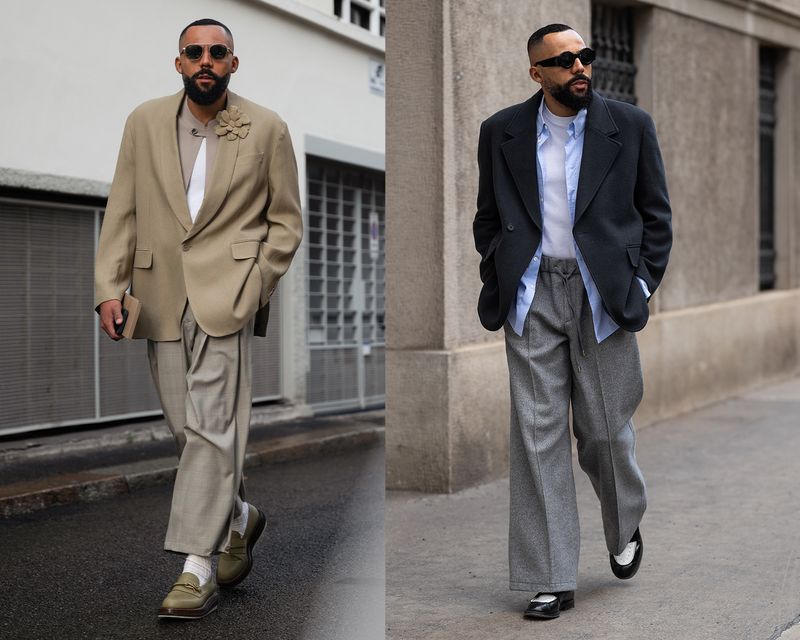THE JOURNAL

From left: photograph by Pius Martin; Samir Novotny; Pius Martin
For any regular reader of The Journal, Jean-Claude Mpassy will be a familiar face. The Vienna-based creative is a street style regular with an inherent knack for making tailoring look both exceptional and effortless. His approach to style, he says, is “to fit in, but look different at the same time”. Mission accomplished, then. Wondering how he nails it every time – and how you can, too? Read on for Mpassy’s suiting masterclass.
01. Find your fit
“The first steps to finding a great suit are knowing what you're looking for, which occasions you need it for and what your silhouette is. For example, I have broad shoulders, so I like my blazers unlined because it gives more freedom. During summer, unlined is a big thing for me, too. I’m 100 per cent a double-breasted blazer guy, because you can also wear them as jackets. Regarding the trousers, it’s important to find your silhouette and stick to it. For me it’s the wider ones. I also love a good trouser pleat – they always add a little something extra.”
02. Get some go-to brands
“I love relaxed and contemporary silhouettes when it comes to tailoring. Something that you feel comfortable in while looking smart and chic at the same time. Brands such as Jil Sander or Jacquemus really embody that. People who know me know that I’m big Dries Van Noten fan. He has probably been my biggest inspiration when it comes to styling and combining different prints and colours. I’m obviously sad that he chose to end his career in fashion, but I’m thrilled to see what Julian Klausner will bring to the table.”
03. Focus on the finer details
“I’m a big fan of patch pockets – you can really use them. As opposed to flat ones, which, if you stuff them with your keys and things, it’s going to look ridiculous. But with patch pockets, they’re very pragmatic, very functional. The lapels are very important, too. I love wider lapels for a vintage reference.”

From left: photograph by Pius Martin; Onur Cicek; Pius Martin
04. You don’t necessarily need a “summer suit”
“Linen has its place, but I’m not a big fan. I like things to look clean and I love to iron – it’s like therapy, I love when things get back in shape and look like new again. Linen is comfortable, it’s breathable, I get it – but if you’re hot, just remove your blazer. Wear regular cotton trousers with a shirt or a tee. Or what you can do is a linen blend, a linen-cotton mix for instance, which is always a good option.”
05. Accessories are key
“Back in the day, if you were wearing a suit, you’d wear a leather strap watch. But all kinds of watches are big right now and can work with tailoring. And, while it’s not an accessory per say, fragrance is something to consider, too. Key chains are always a great way to break a suit. Especially if you’ve got high-waisted pleated trousers, they would be my go-to accessory. We had a big jewellery phase with people wearing like five, six, seven different rings, but the older I get, I think keep it simple and comfortable. That’s the most important thing.”
06. Remember, footwear isn’t an afterthought
“A loafer is a great option, literally for everything. If you wear tailored suits, tailored trousers, denim, even casual sweatpants, you can wear loafers. If you want to be super elegant an Oxford is always great, but it's more of a special occasion shoe in my opinion.”
07. Invest in everyday and occasion suits then get creative
“For me there are everyday suits, like the ones from Lardini, AMI PARIS or Jacquemus. They are all very on trend and come with a little twist in terms of details and silhouette. And then there are special occasion suits, like when you treat yourself to a Brunello Cucinelli or ZEGNA suit after closing a great deal or in preparation for a big event. When it comes to investing in good suits, I always recommend to not only think in full suits, but to think about how you can wear the blazer or trousers with other items to create numerous broken-suit styles. Why not mix some Paul Smith trousers with a Lardini blazer to create a tonal look and get the most out of your wardrobe?”

From left: photograph by Pius Martin; Onur Cicek; Pius Martin
08. Be trend aware
“I would consider myself to be an early adopter when it comes to trends – once they go mainstream, I’m looking for the next thing. For instance, when it comes to tailoring, ties are big again. I started wearing ties a year ago. What’s next? There’s obviously a trend for super-short shorts, but it’s not mainstream enough. On a wider scale, classics like super flat sneakers are very popular right now – and also go very well with a suit.”
09. Don’t be colour shy
“It’s always a great idea to spice things up and add some louder key pieces to a suit. Sleeveless knits, such as those from Marni, are a big thing for me. Especially if you style them with some high-waisted pleated trousers. Also, Missoni shirts or polos are a great way to put your suits into summer mode.”
10. It’s about how you feel
“The great thing about a suit is how it makes you feel and how it makes you stand. Essentially, if a man wears a suit, he stands differently. He probably feels differently, and he’s going to be treated differently. Sitting with your friends at a dinner where everybody’s just casual and you’re wearing a suit, the waiter is probably going to give you the check. Which is a funny experience, but it’s probably going to happen.”